I have a small dog that I have been hiking with one time. It was a good experience and I look forward to going hiking with him again. Just like walking with your dog, hiking can be a great experience for your dog. They love to get out and explore.
You can usually hike about two times as long as you would normally walk with your dog. Each dog is different, and as you hike, check in with your dog and see how tired they are. You’ll find out quickly how much energy they have left. Look at the table for the approximate hiking miles range for their first hike.
| Fitness Level | Small Breeds | Medium Breeds | Large Breeds |
|---|---|---|---|
| Low | 1-3 Miles | 2-3 Miles | 2-3 Miles |
| Medium | 3-5 Miles | 4-6 Miles | 4-6 Miles |
| High | 5-10 Miles | 6-15 Miles | 6-15 Miles |
If you continue to train and hike with your dog, they should be able to walk for longer periods than shown on the chart. The best way to find out is to try going for a hike and watch how your dog performs. For the best result on your hike, read this article to find out everything you need to do when hiking with your dog to see how far they can go.
Venturing into the wilderness with a group of friends or a partner is one thing, but heading up the trail with your dog is something else entirely.
With the company of your positive pup, you’ll have way more enjoyable and also be able to give them a taste of exactly how you like to go and explore the great outdoors.
As well as this, it lets them experience sights, sounds, and smells they wouldn’t usually get to, and it’s also a great way to keep your dog fit – and a bit more adventurous than another walk around the block or the park. All in all, it’s a wonderful and stress-free way of tightening your bond with one another, and something to remember too.
But before you both head on an adventure – big or small – it’s important to bear in mind both you and your dog’s safety when on the trail, just to make sure nothing bad happens, so you can maximize your fun.
How to Train Your Dog for Backpacking
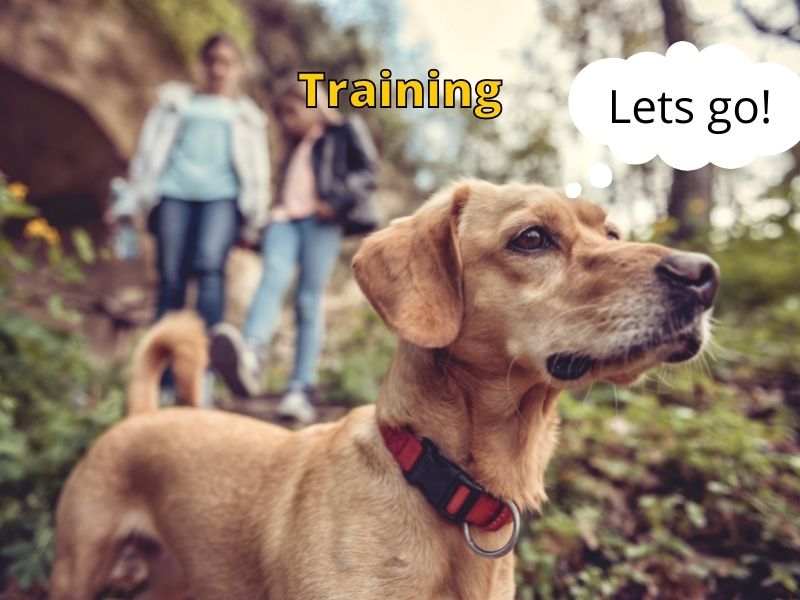
The same way we can’t jump onto the most challenging trail without any prior experience, our dogs need to be eased into these big hikes too. This is especially so if your dog is small or still growing, as the different terrain can prove to be a big challenge.
But if you think your dog is both big and brave enough, and you’re ready to train them to become the best backpacking buddy, here are a few things you should consider:
1. Try Exercises
As well as slightly more challenging walks, getting your dog used to things like jumps and hops will help them when they face this on the trail.
Try this first at home in a safe environment like the backyard, and then slowly implement it in outside true-to-life environments to see how they find it.
Again, make sure to build up the challenge gradually, as pushing them to something too difficult may break their enthusiasm, and even end up causing an injury.
2. Train for Endurance
Once your dog is comfortable with a simple walk in the park or a leisurely trail, it’s time to build up to something a bit more challenging. Take them on a longer walk or a slightly more difficult route just to see how they manage, both physically and mentally.
Take note of what they find easy and what they find hard, just to keep on top of things. As well as their general aerobic fitness, their paws, noses, and joints will need to get used to these different environments. They may even need to adjust to the weather in different places, such as cold or rain.
Introducing these things slowly and with gradual changes will mean your dog won’t be put off and will slowly build up their fitness and confidence for something more difficult.
3. Put a Backpack on Your Dog
It’s hard enough at times to carry your own stuff when going on a long hike, so carrying your dog’s stuff, too is something you’d rather avoid if you can.
Teaching your dog to wear a dog backpack is a great way of getting them to take some of the weight, as well as showing them the importance of being self-sufficient when out on the trail. The important thing with dog backpacks is that their usage should be gradual.
Rather than loading them up with a load of weight and taking them on the trail, start by getting them used to an empty backpack at home, and then, as time goes on, gradually add more weight, and take them on more challenging walks.
How your dog finds wearing a backpack is largely dependent on the dog itself, as well as its age and size. Some dogs take to them straight away without an issue, whilst some take weeks or even months to accept the idea.
Take your time with it and ease your pup into the idea – it’ll be worth it when the weight is off your shoulders. Literally!
4. Help Your Dog Adjust With Water
As well as different grounds and terrains, you’ll also encounter things like puddles, rivers, ponds, and streams when out on the trail.
Some of these can be avoided but need to be carefully navigated in order to carry on. Get your pup used to the idea of paddling through puddles and then swimming. Try this in the bath or in a paddling pool just to ensure safety.
They need to be comfortable not only with water in general but also with different temperatures. Water on the trail is likely to be cold, so they’ll need to be used to this beforehand in order to tackle this successfully on the hike.
Benefits of Hiking With Your Dog
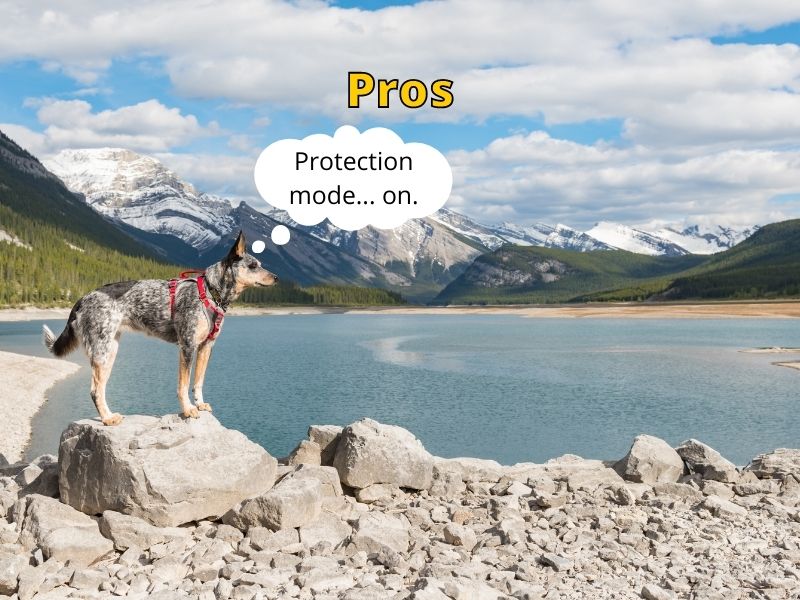
Here are the key benefits you’ll get when choosing to go hiking or backpacking with a dog friend, rather than hitting the trail solo:
It’s Safer
Although they can’t exactly call the emergency services, having your dog with you can certainly make you feel like you’re in good hands.
Not only can they bark to get your or other people’s attention, but attaching a light or high-viz jacket to them can make you more visible should anyone need to search for you.
Is a Dog Good Company on a Hike?
Dogs are known to be the most positive and upbeat animals on Earth – so taking them out with you can only lead to better times. Whether it’s just the two of you or your dog tags along with the group, they will surely bring the mood up!
What Will Keep Your Dog Warm During the Night?
If you’re planning on camping out somewhere, sleeping next to your pup will certainly keep you warmer (if a little smellier) than sleeping solo. It’s also another way to not feel so alone when facing the wilderness in the dark.
Dogs Are Entertaining
Dogs are hilarious. Whether it’s falling in puddles, running in circles, or just being great fun – bringing your dog will definitely make it a more worthwhile and comedic experience than going alone.
Disadvantages of Hiking with Dogs

Despite the many positives of choosing to bring your best pal with you, there are a few downsides too, so it’s worth bearing these in mind before choosing whether to bring them along or not:
You Will Have to Prepare Yourself for Extra Load
Although some dogs will have no issue carrying their own gear, if your dog’s particularly small or young, or just a certain breed, they might not be able to carry any more than their own weight.
This means that you’ll have to carry their stuff – food, toys, poop bags – yourself, leading to more weight on your back. Although this isn’t a huge deal, it can really make a difference on those long trails.
Dogs Can’t Give You Their Opinion
Whether it’s which way to go, if you should have a break, or whether they want to take a detour to check something out, unlike humans, your dog can’t talk back, meaning you’ll have to make all the decisions by yourself.
You Must Be Selective in Where You Hike
Not all trails that are open to humans are open to dogs as well. Some trails occasionally restrict access to animals due to the animals already on the trail or for safety reasons for other hikers. Whatever trail you plan to go on, you’ll have to double-check this.
Things You Must Have with You When Hiking with Your Dog
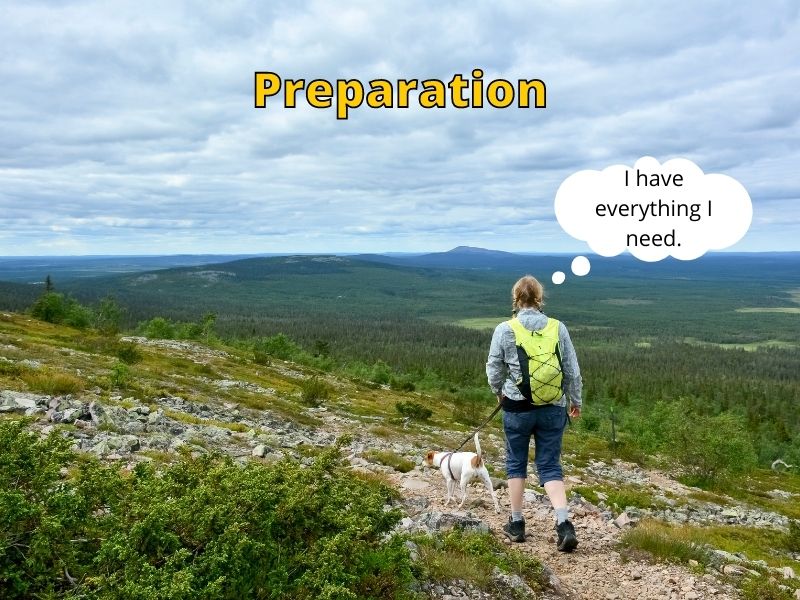
Before heading out, there will be a few things you’ll need to take with you, especially if your pup is accompanying you on the way, so keep note of these just to make sure you don’t forget them:
Leash
Even if your dog is the most obedient pup on the planet, it’s still a good idea to bring a leash with you. Should the trail get busy, or the weather change, or whatever other reason, you’ll want to know that you’re able to have them by your side without the worry that they’ll get lost or go astray.
Plastic Bags
Even when out in the wild, you shouldn’t let your dog poop without cleaning it up. Bring a pair of disposable gloves or a scoop, as well as a bag, and if your dog drops one, make sure to clean it up.
ID Tag
Your pup should always have some kind of ID on them – usually in the form of a tag. You’ll want the owner’s name, address, and contact number so anyone can locate you if your dog happens to get lost.
Snacks
Like with water, your dog will also need food and snacks to keep their energy levels up and fill up on those lost calories. Bringing healthy snacks that are full of fiber will work best, as it’s a more natural way for you and your dog to retain slow energy that will work continuously throughout the day.
Water
Not only will you need to stay hydrated when out and about, but so will your pup. Either bring a little bowl that you can decant the water into every now and then or give them a dedicated bottle to drink from. You should drink small amounts a few times every hour rather than a lot in one go.
First Aid Kit
If you’re going on a casual walk close to home, a first aid kit probably isn’t necessary. But for any longer trips in more remote places, it’s crucial that you bring at least the basics. You won’t need a defibrillator or a sewing kit, but a few blasters, a bandage, and some alcohol wipes should do the trick.
You probably won’t end up breaking your neck, but if you graze your knee or cut your hand on a rock, you’ll want to be able to deal with this and keep it clean for the remainder of the hike.
Hiking Trail Etiquette
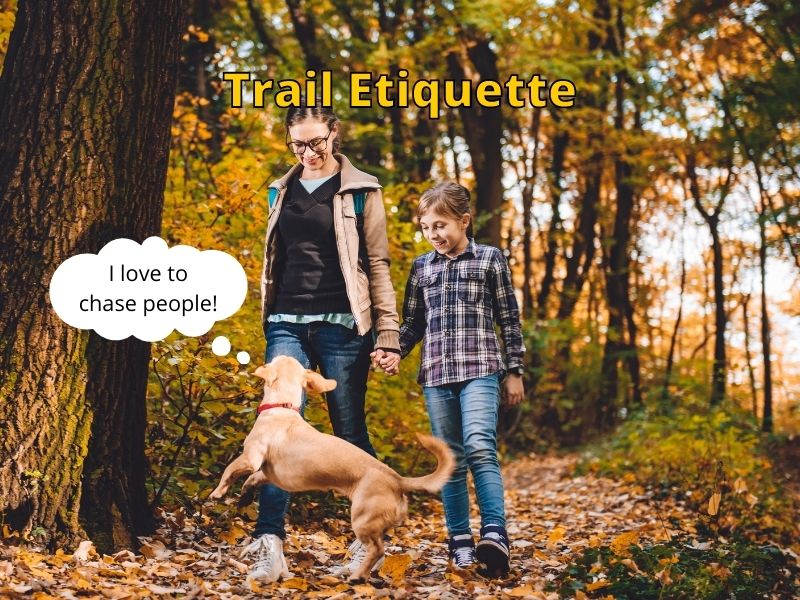
Although nearly all trail-goers love dogs, it’s still important to pay attention to the etiquette required when you’re on the trail:
- Give Space to Other Hikers: Make sure to give other hikers room when passing, even if this means stepping off the trail.
- Clean After Your Dog: Whether it’s poop, sick, or food wrappers, you should leave the trail as you found it. Not only does this ruin the natural experience, but it can also be a danger to other people or dogs, as well as encourage others to do the same.
- Don’t Have More Than Two Dogs per Person: Even if you’re an experienced dog walker, when out on a trail you shouldn’t have more than two dogs. The added energy required, as well as the unfamiliar or challenging landscape, means you’ll want to have a lot more focus than usual. Limiting yourself to two dogs means that you’ll always stay alert and won’t be overwhelmed.
Wildlife Safety Tips When Hiking with Your Dog
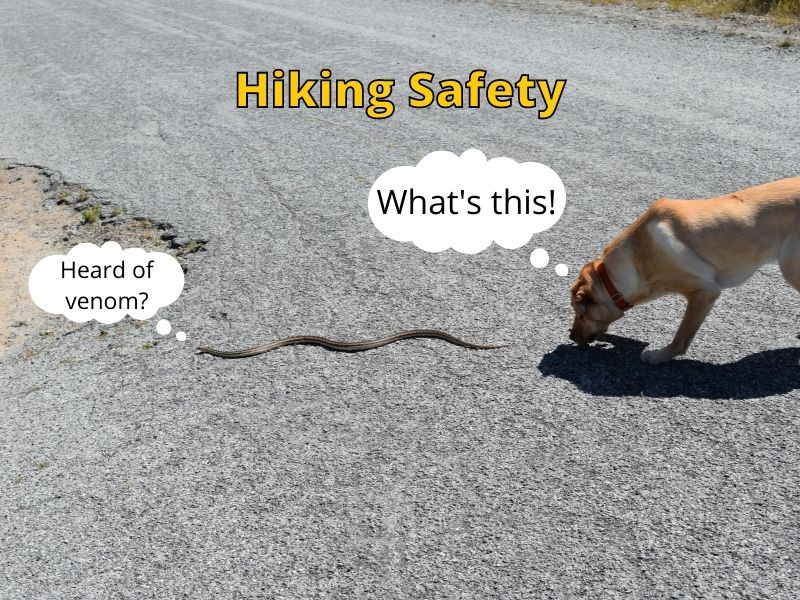
Being in a new environment, you and your dog are likely to encounter different kinds of wildlife whilst out on the trail.
Although these are likely to be harmless, you should be wary and do your best to keep you and your pup at a safe distance in order to avoid any conflict.
Deer
Most deer will fear you more than you fear them, so they’re likely to run off if you get too close. Having said that, mature males have been known to attack humans and cause serious damage, so bear this in mind, and avoid them as much as you can.
Skunks
Although they seem only to appear in kids cartoons, skunks are actually common in certain wildlife areas and are encountered by many hikers on their trails.
Some skunks have rabies and are likely to attack or confront other animals. They can spray foul-smelling substances up to 15 feet away, so be sure to keep your distance!
Raccoons
Raccoons aren’t usually spotted that often, but these should be avoided too. Dogs tend to be attracted by the scent of their excrement, so if you see your dog wandering off with their nose in the air, this might be the reason.
Raccoons can, however, carry nasty viruses, so be wary of your dog, and if one is spotted, keep your distance and carry on.
Porcupines
Porcupines can also cause quite a hazard. Although they’re unlikely to attach, if you get too close, they’ll erect their quills which are sharp needle-like things that protrude from their skin.
If these get stuck in your or your dog’s flesh, you’ll have to seek medical help immediately in order to get these removed. This is another reason to keep your dog close and invest in a leash, even if just for the trail.
Wild Cats
Wild cats are also one to be avoided. Although they’re likely to flee when extremely hungry, they have been known to confront humans and animals. If you encounter one, make yourself large by spreading out your arms and standing tall.
It’s also a good idea to make some kind of threatening noise to warn it off. Stomp your feet or bang a nearby tree with a stick – whatever you do, make sure to let it know you’re in control, and it should leave you alone.
Bears
This is the one animal that you’ll definitely want to be wary of if you want to get home from the trail in one piece. Bears are rarely spotted nowadays, tending to stay within the more remote areas of the wilderness, but some travelers and hikers have been known to spot them venturing closer to popular areas in order to get food.
If you’re one of the unlucky few to encounter one, back away slowly and don’t make any sudden movements. Make sure to keep your dog calm so they don’t run or bark. And if the bear starts charging, run!
Final Thoughts
Taking a long hike out in the wilderness can be an amazingly fulfilling experience, and doing it with your best pup pal can only make the experience greater.
But when taking your dog out on the trail with you, it’s important to bear certain things in mind, in order to keep both of you safe and maximize your experience together.
Be prepared for potential encounters with wildlife, bring some small first aid supplies to deal with any potential cuts or bruises, and respect the trail as you would your own home, leaving no litter or poo behind. But more important than all, enjoy it – it’s a great bonding experience for you and your dog!
Thanks for visiting Helpshoe.com
References
https://pawsitivelyintrepid.com/how-far-can-a-dog-hike-in-a-day/

